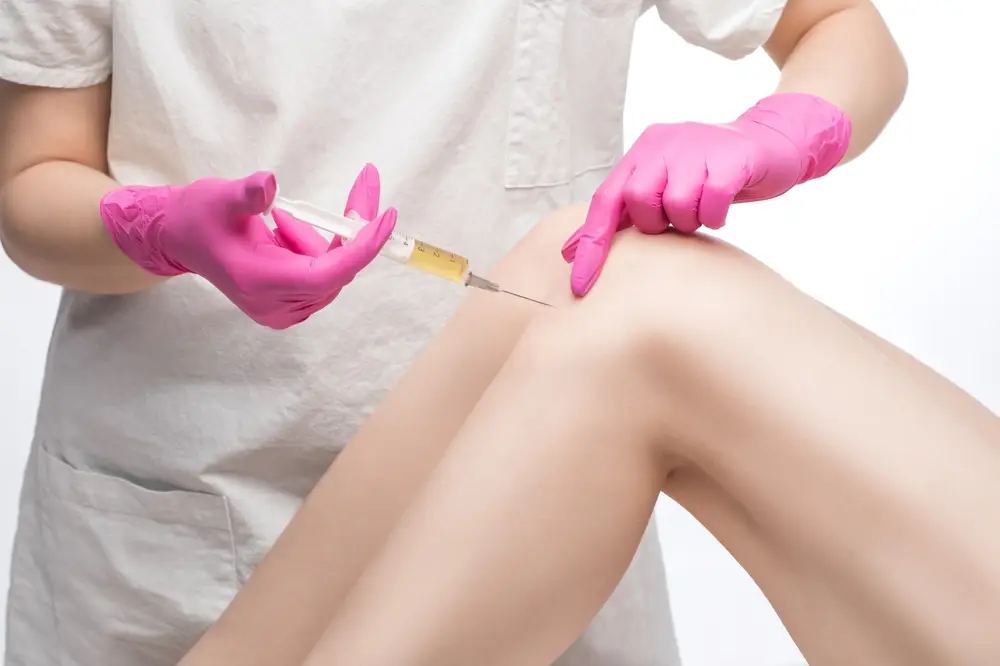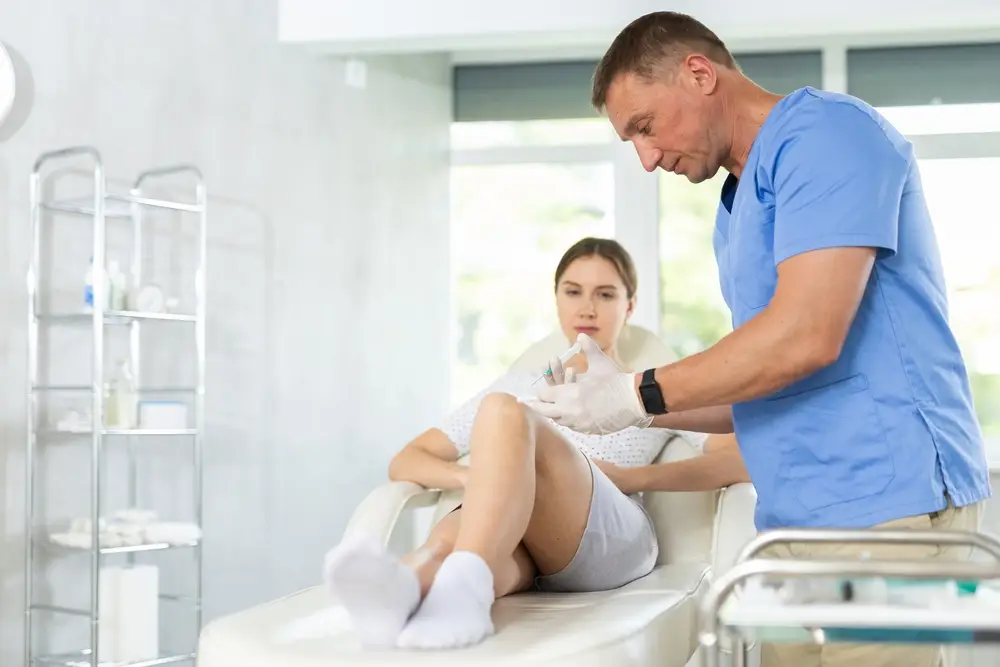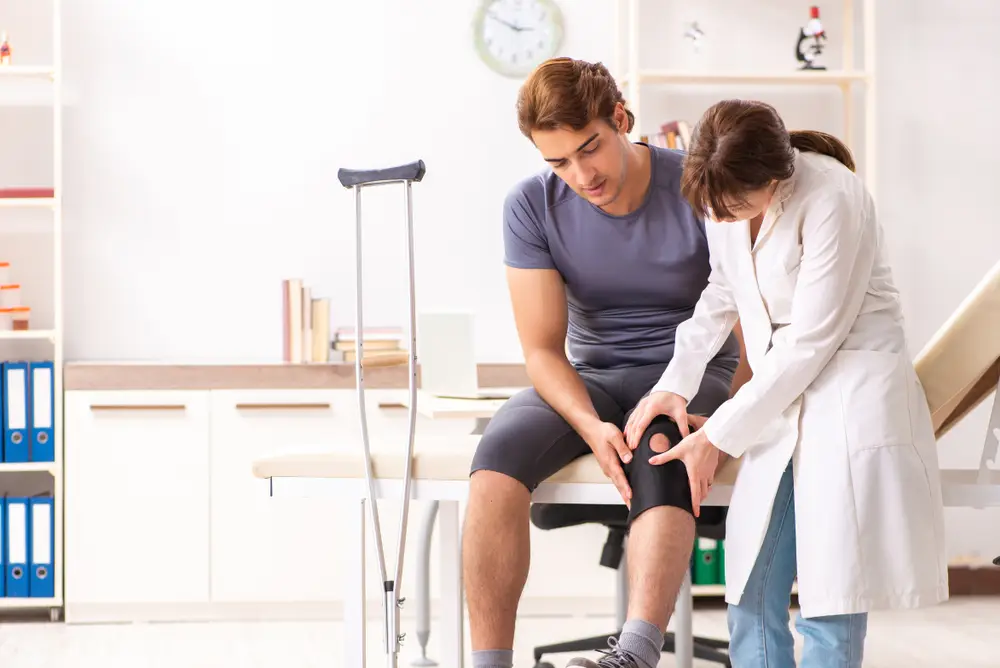Table of Contents
- What to Expect and How to Optimize Healing
- What Are Knee Gel Injections? Your Questions Answered
- Types of Knee Gel Injections: Which Is Best for You?
- Gel Injections vs. Cortisone Shots: Which Is Right for You?
- Who Is a Good Candidate for Knee Gel Injections?
- The Gel Injection Procedure: What Happens Step-by-Step
- How Effective Are Gel Injections? What to Expect Long-Term
- Recovery Timeline: What to Expect After Gel Injections
- Risks and Side Effects: What You Need to Know
- Insurance and Cost: Navigating Affordability for Gel Injection
- Who Provides Knee Gel Injections? Finding the Right Specialist
- FAQs: Your Top Gel Injection Questions Answered
- Conclusion: Take the Next Step Toward Pain-Free Knees
Gel Injection in Knee Recovery Time: What to Expect and How to Optimize Healing
If you’re struggling with inside knee pain that makes everyday activities like walking or climbing stairs a challenge, you’re not alone. Millions of people battle knee osteoarthritis (OA) or joint wear-and-tear—but surgery isn’t your only option. Enter knee gel injections, a breakthrough treatment designed to lubricate stiff joints, reduce pain, and help you reclaim your mobility. In this guide, we’ll unpack how gel injections for knees (also called viscosupplementation) work, who they help, and what you can expect during recovery. Let’s dive in!
What Are Knee Gel Injections? Your Questions Answered
Knee gel injections, often nicknamed “gel shots for knee” or “knee injection gel,” are a minimally invasive treatment for osteoarthritis and joint pain. Think of them as a “liquid cushion” for your knees! Here’s how they work:
The Science Behind Viscosupplementation
Your joints naturally contain hyaluronic acid (HA), a thick fluid that acts like shock-absorbing grease. Over time, arthritis breaks down HA, leading to friction, inflammation, and that nagging inside knee pain. Gel injections for knee replenish this lost fluid, restoring smooth movement and easing discomfort.
- How It’s Done: A doctor injects hyaluronic acid (or a synthetic version) directly into the knee joint.
- Alternate Names: You might hear them called viscosupplementation, gel shots for knees, or hyaluronic acid injections.
- Key Benefit: Unlike cortisone shots, which mask pain temporarily, gel injections tackle the root cause by improving joint health.
Who Invented This?
Fun fact: The FDA first approved hyaluronic acid injections in the 1990s, and they’ve since become a gold standard for OA patients seeking non-surgical relief.

Types of Knee Gel Injections: Which Is Best for You?
Not all gel injections for knees are the same! Brands differ in how they’re made, how many shots you’ll need, and how long results last. Here’s a breakdown of the most common types:
A. Hyaluronic Acid (HA) Injections
These are the most widely used knee injection gel options. Popular brands include:
- Synvisc-One®: A single-injection formula that’s ideal for busy lifestyles.
- Euflexxa®: Made from fermented bacteria, it’s a great choice for patients with avian (bird) protein allergies.
- Orthovisc®: Requires 3–4 injections spaced a week apart but lasts up to 6 months.
B. Platelet-Rich Plasma (PRP) Therapy
While not technically a gel shot for knee, PRP uses concentrated platelets from your blood to reduce inflammation and promote healing. It’s pricier but popular among athletes.
C. Combination Therapies
Some clinics pair gel injections with physical therapy or corticosteroid shots for faster relief.
How Do Doctors Choose the “Best” Knee Gel Injections?
Your orthopedic specialist will consider:
- Severity of Arthritis: Mild OA may respond well to 1–2 shots, while advanced cases need stronger formulas.
- Lifestyle: Active patients often prefer longer-lasting options like Synvisc.
- Budget: Insurance coverage varies—more on that later!

Gel Injections vs. Cortisone Shots: Which Is Right for You?
If you’re exploring knee injection options, you’ve likely heard about both gel shots for knees and cortisone injections. While both aim to ease pain, they work in very different ways. Let’s break it down so you can make an informed choice:
How They Work
- Gel Injections (Viscosupplementation):
- Goal: Replace lost joint fluid to restore cushioning and reduce friction.
- Best For: Long-term relief for osteoarthritis (OA) or chronic inside knee pain.
- Recovery Time: Results build over weeks, with full effects in 4–6 weeks.
- Cortisone Shots:
- Goal: Reduce inflammation fast with a steroid medication.
- Best For: Sudden flare-ups (e.g., post-injury swelling).
- Recovery Time: Knee pain relief in 24–48 hours, but effects fade in 1–3 months.
Key Differences
Pro Tip: Many patients combine both! A cortisone shot can ease acute inflammation before starting gel shots for knees for lasting results.
Who Is a Good Candidate for Knee Gel Injections?
Not everyone with inside knee pain is a match for gel injection for knee therapy. Here’s who benefits most:
Ideal Candidates
✅ Moderate Osteoarthritis: X-rays show cartilage loss but not bone-on-bone.
✅ Active Lifestyles: Runners, hikers, or gym-goers wanting to delay surgery.
✅ Failed PT/Medication: Pain persists after physical therapy or NSAIDs.
✅ Avoiding Surgery: Older adults or those with high surgical risks.
Who Should Skip Gel Injections?
❌ Severe Joint Damage: Bone-on-bone arthritis often needs surgery.
❌ Infection or Skin Issues: Open wounds near the knee increase infection risks.
❌ Allergies: Rarely, some react to hyaluronic acid (check with your doctor!).
Did You Know? Athletes like marathoners and tennis pros often use knee gel injections to stay competitive while managing wear-and-tear.

The Gel Injection Procedure: What Happens Step-by-Step
Worried about the process? Let’s demystify what it means to inject knee with gel:
Before the Injection
- Consultation: Your doctor reviews MRI/X-rays to confirm OA.
- Prep: Avoid blood thinners (e.g., aspirin) for 3–5 days to reduce bruising.
During the Procedure
- Step 1: The knee is cleaned, and a local anesthetic numbs the area (optional).
- Step 2: Using ultrasound guidance, the doctor inserts a thin needle into the joint.
- Step 3: The gel injection is administered over 1–2 minutes.
- Step 4: You’ll gently bend the knee to spread the fluid evenly.
Does It Hurt? Most patients report mild pressure, not pain. Think of it like a flu shot for your knee!
After the Injection
- Immediate Care: Ice the area for 15 minutes to curb swelling.
- Activity Restrictions: Avoid strenuous exercise for 48 hours.
Common Side Effects
Most knee gel injections side effects are mild and fade in 1–3 days:
- Temporary swelling or warmth at the injection site.
- Mild stiffness (improves with gentle stretching).
- Bruising (rare; more common in patients on blood thinners).
Rare Risks: Infection (<1% of cases) or allergic reactions (report sudden redness or fever ASAP).
How Effective Are Gel Injections? What to Expect Long-Term
Let’s tackle the big question: Do best knee gel injections actually work?
Effectiveness by the Numbers
- 75% Success Rate: Studies show 3 in 4 patients report significant pain reduction.
- Improved Mobility: Walking distance increases by 30–50% in responders.
- Delayed Surgery: 60% of users postpone knee replacement for 2+ years.
How Long Do Results Last?
It depends on the brand and your body’s response:
- Single-Shot Brands (e.g., Synvisc-One): 6–9 months.
- Multi-Shot Brands (e.g., Euflexxa): Up to 12 months.
Pro Tip: Pair gel injection knee recovery with low-impact exercises (swimming, cycling) to extend results.
Factors That Affect Longevity
- Weight: Losing 10+ lbs reduces joint stress and prolongs benefits.
- Activity Level: Avoid high-impact sports like basketball.
- Follow-Up Care: Annual booster shots are common for chronic OA.
Real-World Example: Maria, a 58-year-old teacher, avoided knee surgery for 3 years using gel shots for knees combined with weekly yoga!

Recovery Timeline: What to Expect After Gel Injections
Navigating gel injection in knee recovery time can feel overwhelming, but knowing what’s ahead helps you prepare. Here’s a detailed, phase-by-phase guide to your healing journey:
Phase 1: Immediate Recovery (First 48 Hours)
- What Happens: Mild swelling or warmth around the injection site is normal.
- Aftercare Tips:
- Rest: Avoid standing for long periods or strenuous activities.
- Ice: Apply an ice pack for 15 minutes every 2–3 hours to reduce swelling.
- Medication: Over-the-counter pain relievers like acetaminophen can ease discomfort.
Pro Tip: Keep your leg elevated while icing to boost circulation and reduce stiffness.
Phase 2: Short-Term Healing (Days 3–7)
- Progress Check: Most swelling subsides, but you might feel lingering inside knee pain during movement.
- Activity Do’s and Don’ts:
- Do: Gentle stretches, short walks, or swimming.
- Don’t: Run, jump, or lift heavy weights.
Transition Tip: Gradually reintroduce activities—think “slow and steady” to avoid setbacks.
Phase 3: Medium-Term Recovery (Weeks 2–4)
- Turning Point: Many patients report significant pain relief as the gel fully integrates with joint fluid.
- Exercise Plan:
- Low-impact workouts (cycling, yoga).
- Physical therapy exercises to strengthen surrounding muscles.
Real-Life Example: John, a 62-year-old gardener, returned to light yardwork by week 3 after his gel shots for knee aftercare plan.
Phase 4: Long-Term Results (Month 2+)
- Peak Benefits: Maximum pain relief and improved mobility kick in.
- Maintenance:
- Schedule follow-ups if pain returns.
- Consider annual booster injections for chronic OA.
Key Stat: 70% of patients maintain results for 6–12 months with proper care.
Your Aftercare Checklist
- Avoid High-Impact Activities for 4–6 weeks.
- Track Progress: Note pain levels daily in a journal.
- Stay Consistent: Follow your PT regimen to protect the joint.
Risks and Side Effects: What You Need to Know
While knee gel injection risks are rare, being informed helps you act quickly if issues arise.
Common Side Effects (Manage at Home)
- Swelling or Warmth: Usually fades in 1–3 days (ice and rest help!).
- Stiffness: Gentle stretches improve flexibility.
- Bruising: More likely if you’re on blood thinners—apply arnica cream.
Inside Knee Pain After Injection?
This is normal! It’s often caused by temporary inflammation. If pain worsens after 72 hours, contact your doctor.
Rare Risks (Seek Medical Help)
- Infection (<1% risk): Signs include fever, redness, or pus.
- Allergic Reaction (rare): Itching, rash, or trouble breathing—go to the ER.
- Fluid Accumulation: Severe swelling may require drainage.
Safety First: Always choose a board-certified specialist to minimize gel knee injections side effects.
When to Call Your Doctor
🚨 Persistent pain lasting >1 week.
🚨 Inability to bend the knee or bear weight.
🚨 Sudden warmth/redness spreading beyond the injection site.

Insurance and Cost: Navigating Affordability for Gel Injection
Understanding the knee gel injections cost is crucial for making informed decisions. Here’s a breakdown of what to expect and how insurance can help:
How Much Do Gel Injections for Knees Cost?
- Average Price:
- 300–1,500 per injection, depending on the brand and provider.
- Additional Fees: Clinic charges, imaging guidance (ultrasound/X-ray), or follow-up visits.
Does Insurance Cover Knee Gel Injections?
Most plans cover gel injections for knees if:
- You’re diagnosed with osteoarthritis (confirmed by X-ray/MRI).
- Conservative treatments (PT, NSAIDs) failed.
- Prior Authorization: Your doctor may need to submit evidence of medical necessity.
Pro Tip: Call your insurer’s customer service before scheduling to confirm coverage and avoid surprise bills.
Financial Assistance Options
- Patient Assistance Programs: Brands like Synvisc offer discounts for uninsured patients.
- Payment Plans: Many clinics split costs into installments.
Who Provides Knee Gel Injections? Finding the Right Specialist
Not all providers are equal! Here’s how to choose experts for knee gel injection therapy:
Types of Providers
- Orthopedic Surgeons: Specialize in joint treatments and advanced OA cases.
- Rheumatologists: Ideal for patients with inflammatory arthritis (e.g., rheumatoid).
- Sports Medicine Doctors: Focus on athletes and active individuals.
- Physiatrists (PM&R): Experts in non-surgical pain management.
Why Choose a Gel Injection Specialist?
- Accuracy: Ultrasound-guided injections ensure the gel reaches the joint space.
- Experience: High-volume providers (like HSS) report fewer complications and better outcomes.
- Customization: They’ll recommend the best knee gel injections for your lifestyle and budget.
Red Flags to Avoid:
- Clinics pushing unnecessary upsells (e.g., unproven supplements).
- Providers who skip imaging to confirm OA.

FAQs: Your Top Gel Injection Questions Answered
Let’s tackle the most-searched queries about gel injections for knees:
Q1: How long is the gel injection knee recovery time?
A: Most patients resume light activities in 48 hours, but full recovery takes 4–6 weeks. Avoid high-impact exercises until cleared by your doctor.
Q2: How many injections will I need?
A: It depends on the brand—1 shot (Synvisc-One) or 3–5 shots (Orthovisc) spaced weekly.
Q3: Can I drive home after the procedure?
A: Yes! Numbing agents wear off in 1–2 hours, and driving is safe if you’re not taking sedatives.
Q4: Are results permanent?
A: No—effects last 6–12 months. Many patients repeat injections yearly.
Q5: Do gel injections work for rheumatoid arthritis?
A: They’re FDA-approved only for osteoarthritis. RA patients may benefit from cortisone or biologics.
Explore More: Check our [Recovery Timeline] section for day-by-day tips!
Conclusion: Take the Next Step Toward Pain-Free Knees
If inside knee pain is holding you back, knee gel injections could be your ticket to reclaiming mobility without surgery. From easing stiffness to helping you stay active, gel shots for knees offer a proven, minimally invasive solution backed by decades of research.
